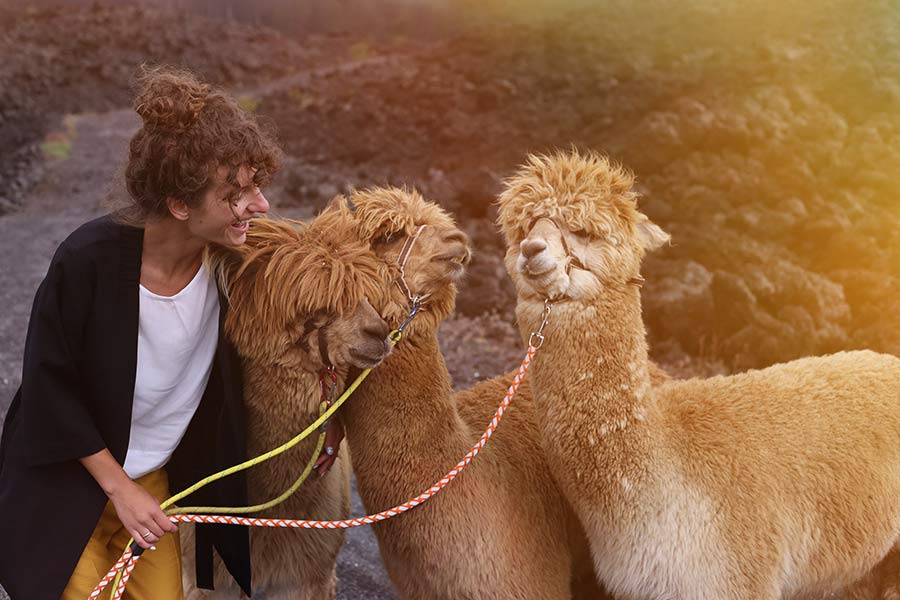Basics of Behavior and Handling of Llamas and Alpacas

Rachel Elliott, Veterinary Student
David E Anderson, DVM, MS, DACVS
College of Veterinary Medicine
So you are thinking of becoming the proud owner of a llama or an alpaca. Welcome to an exciting and growing industry! While camelids are much easier to work with than many traditional livestock, these animals can be challenging at times when it becomes necessary to handle them. To help you as you begin working with these interesting animals, here are a few handling guidelines that should be used. These guidelines will make working with camelids much easier on both you and your llama or alpaca, and they will make any veterinary visits go more smoothly.
One of the most important aspects of camelid behavior to remember is their herding instinct; both llamas and alpacas are extremely herd-oriented animals. This can be both an advantage and a disadvantage as we work with them. One of the benefits of their strong herding instinct is that this can make moving groups much easier. The animals will tend to stay together and make less work for us as we move them. A disadvantage of this behavior is that it makes it difficult to single animals out for individual treatment.
Perhaps the most effective way to overcome this is to use a series of catch pens that gradually become smaller until you are able to separate individual animals. Avoid making sudden movements that can be interpreted as threatening gestures as this may frighten the animals and make it much more difficult to catch those that you need. As you single out the individual that needs your attention, approach the animal slowly and take hold of the neck close to the head. This will allow you more control over the animal, as it will likely try to escape your grasp. For a secure hold that will be safer for you and the animal, place the head in the crook of your elbow and pull it close to your shoulder.
Congratulations, you've captured your first camelid with a minimum of stress and injury to either the animal or yourself. But what do you do with an animal that is adamant about getting away from you? Luckily, there are some tricks that will help you keep control of the animal long enough to treat it. With both llamas and alpacas, one of the easiest methods is "earing". This technique involves bringing the hand not involved in head restraint up along the animal's neck and grabbing the outside ear. Do not use a twisting motion to control the animal, rather, simply squeeze the base of the ear firmly and hold as the animal is treated. This is similar to earing in horses.
Another restraint method used for alpacas is to rest your other hand on the point of the shoulders at the base of the neck and gently but firmly press downward. This should help you to control the animal and keep it still for any treatments necessary. For an animal that is continuously swinging around and not standing still, you may use your free hand to grasp the base of the tail to help hold them in one place. You may also have another person do the same for you, especially with larger animals.
A unique camelid behavior that can be used to our advantage in handling is the "kush." This is a term for sternal recumbency, in other words, when the animal lays down with its legs up underneath its body. Depending on the animal, some llamas and alpacas will kush when you grab their tail, when they are stressed, or for no obvious reason. When the animal does go down while you are trying to handle it, allow it to do so and simply restrain the animal and apply light pressure to encourage it to maintain the posture. This handling method works well when multiple people are in the pen; one or more people can help to hold the animal while another performs the procedure. While not the least stressful handling option, it can be useful when an animal is not willing to submit to any other forms of restraint.
When properly trained, the use of a halter on llamas and alpacas can be invaluable as a handling tool. Training consists of getting the animal used to handling and used to the halter from an early age. Proper halter fit is essential for its use; this is necessary due to camelid nasal anatomy. A good portion of the nose directly behind the nostrils is cartilage rather than bone. Improper halter fit can lead to pinching of the nasal passage and panic in the llama or alpaca as these animals mostly breathe through their nose. Make sure the halter is sized appropriately for a llama or alpaca and that the halter rings are almost to the corner of the eyes. This position will assure that the noseband is sitting past the cartilage on bone. Now you may use a lead rope to direct the animal, giving them an appropriate amount of slack in case something should startle the animal.
These are just a few handling tips that will help to make working with your new llama or alpaca go more smoothly. When you become more comfortable with these procedures and camelid behavior, your experiences as an owner and handler will be much more enjoyable. These skills will also be useful in the event that your llama or alpaca becomes ill; continuing care will be more easily accomplished when you are able to give the medicine prescribed by your veterinarian. When you have questions on animal handling, remember to ask other owners or your veterinarian. They can assist you in becoming better at working with these unique animals.
David E Anderson, DVM, MS, DACVS
Ohio State University
E-mail: Anderson.670@osu.edu
Like this article? Become a RMLA Member today!

